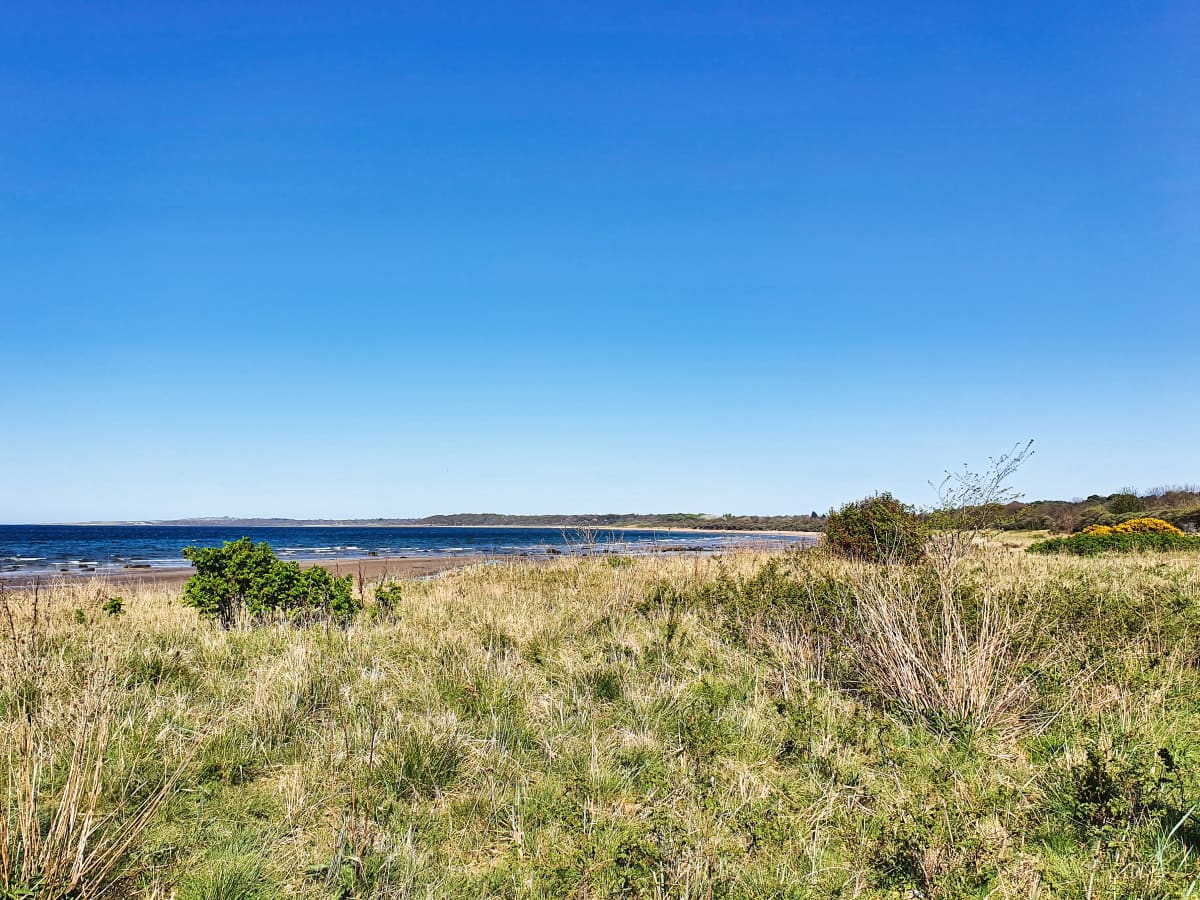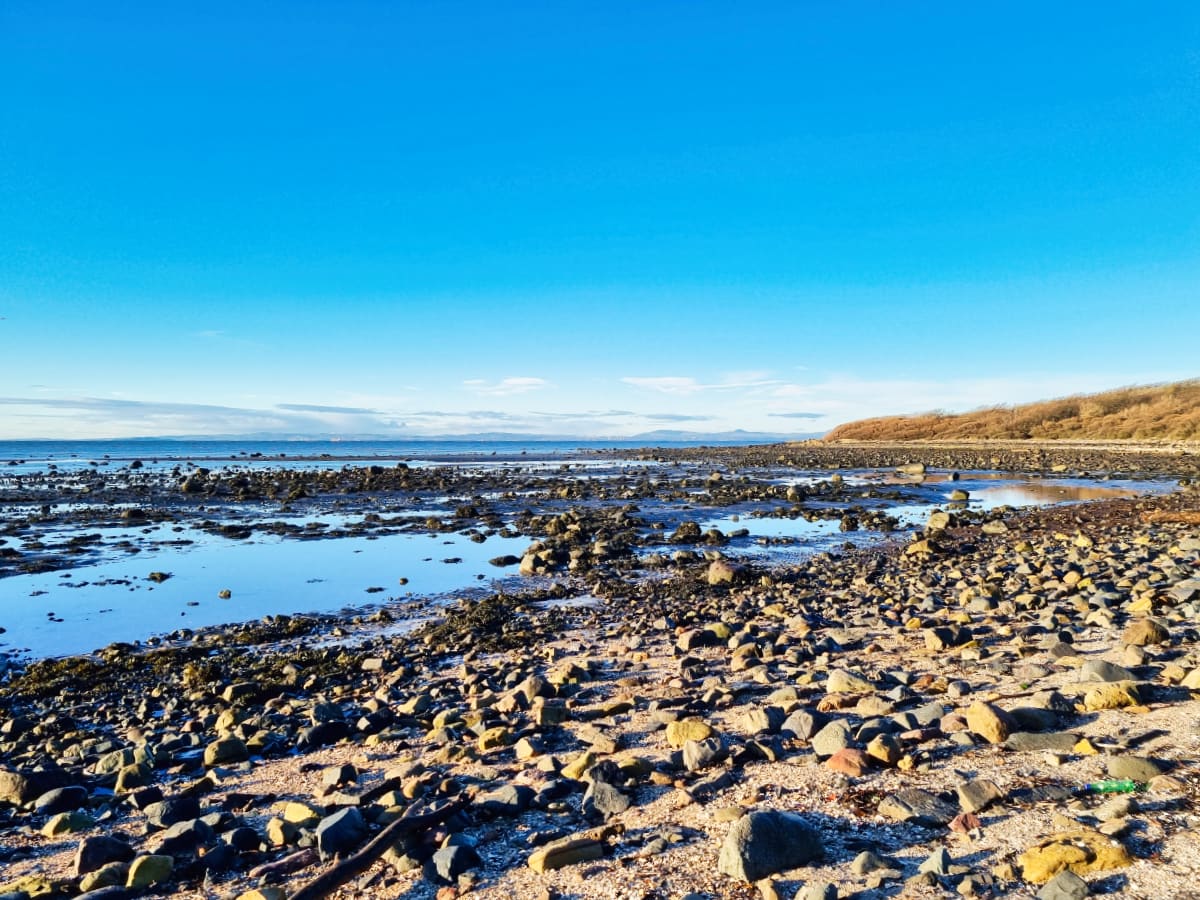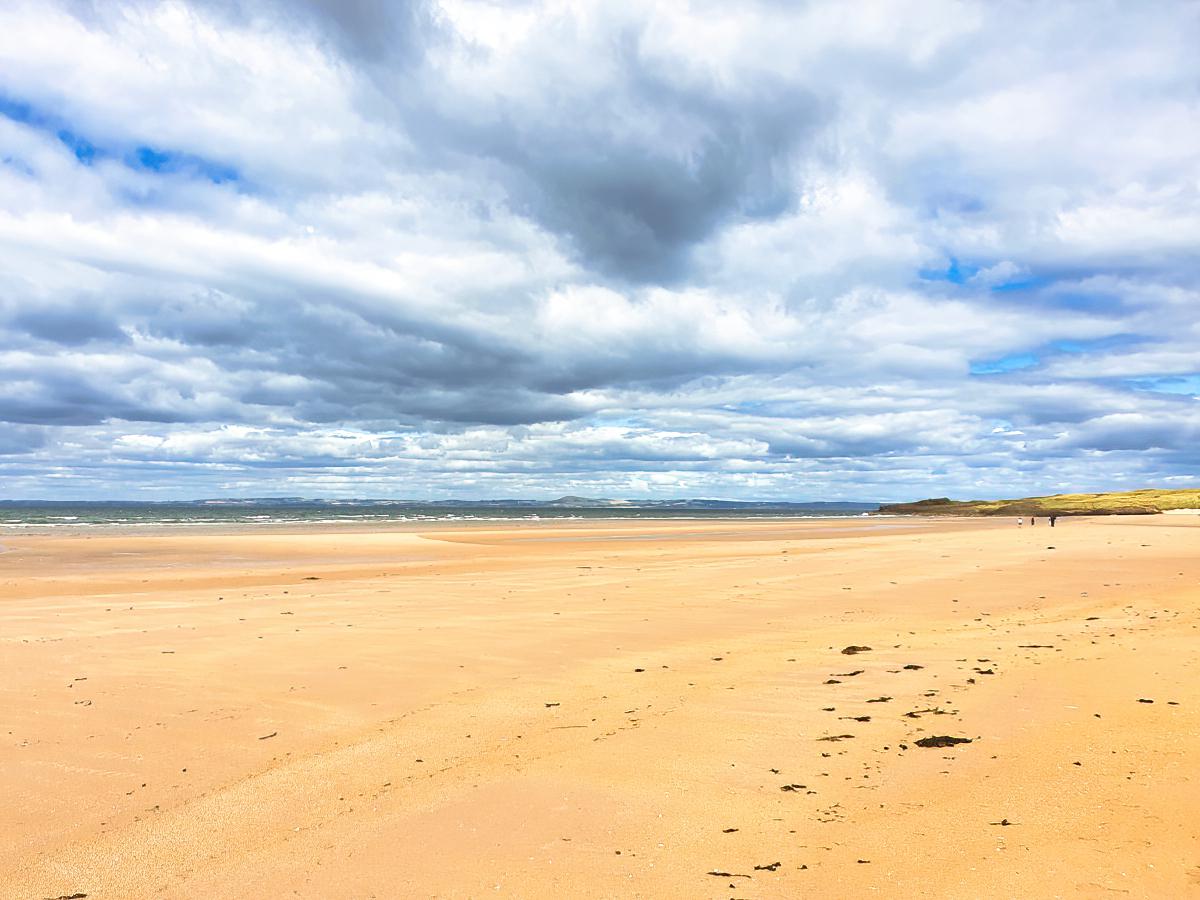In this article, we’ll set out to discover the hidden gems of Scotland’s southeast coastline, specifically around the nation’s capital city of Edinburgh. If you thought Edinburgh was all about its historic castle, mediaeval streets, and lively festivals, think again. Nestled along the shoreline of the Firth of Forth, you’ll find an array of stunning beaches just waiting to be explored, some of which see very few tourists even in the height of summer.
Join me as I take you on a tour of some of the best beaches near Edinburgh, moving west to east from Cramond to North Berwick. Each destination offers a different experience, so you’re guaranteed to find somewhere that’s perfect for you, whether you prefer sunbathing in peace and quiet or getting active on the open water.
Cramond & Silverknowes Beach

| Address: | Cramond, Edinburgh, EH4 6HY |
| Opening Hours: | Open 24/7 Access depends on tide times |
| Admission Price: | Free |
| Parking: | Free parking is available at Cramond car park (postcode EH4 6NU) |
| Contact: | N/A |
| Facilities: | No facilities on Cramond Island Toilets and cafe in Cramond village |
Out About Scotland Guide: Cramond Island
Silverknowes and Cramond beaches lie 4 (ish) miles northwest of the city centre, where they overlook the Firth of Forth and the coastline of Fife. They’re basically one single stretch of sand but are usually referred to as Cramond or Silverknowes, depending on which end you visit.
Cramond is the most westerly beach and is best known for the causeway that links Cramond village to Cramond Island, a small islet sitting just over half a mile offshore. The island is definitely worth a visit, as it has a couple of small beaches as well as the remains of WWII lookout posts and fabulous views of the Forth Bridges.
Moving back to the shore, visitors can enjoy a sweeping stretch of fine golden sand from Cramond to Silverknowes alongside an enormous expanse of seabed that appears for several hours each day when the shallow waters of the Firth of Forth recede.
There’s a wide promenade that links both ends of the beach which is ideal for leisurely strolls, and as you head to the Silverknowes end you’ll usually find snack and ice cream vans parked up on the grassy area near the Boardwalk Beach Club, meaning families won’t have to leave the area to refill hungry bellies.
As far as parking goes, this beach is one of the best on this list as there are two decent-size car parks in Cramond and another even larger parking area on Marine Drive in Silverknowes which presents stunning views of the Forth.
Nearby attractions include Lauriston Castle, a 16th-century tower house with beautiful gardens, while the charming village of Cramond features a picturesque waterfront setting next to the River Almond, a historic church, and several cafes and pubs to enjoy.
Protect Your Family From Scotland's Biting Midges
- Powerful, reliable protection for up to 8 hours
- Water- and sweat resistant
- Repels midges, mosquitoes, horse flies, sand flies, fleas and ticks
- Safe for use on adults, children over 30 months and pregnant women
- Non-sticky, moisturising with a pleasant fragrance
- Packaging may vary
Portobello Beach

| Address: | Portobello, Edinburgh, EH15 2DX |
| Opening Hours: | Open 24/7 |
| Admission Price: | Free entry |
| Parking: | Car parking on Joppa Road (B6415) and Bridge Street car park (postcode EH15 1DD). |
| Contact: | NA |
| Facilities: | Public toilets, cafes, restaurants, swimming pool, play park, snack vans, shops on Portobello high street. |
| Photos: | YouTube Video |
Out About Scotland Guide: Portobello Beach
If you’re looking for nice beaches near Edinburgh, look no further than Portobello. This popular seaside destination is situated on the Firth of Forth’s southern shore, just a few miles east of the city centre which means it’s very easy to get to whether cycling, driving, or taking a bus.
If using Edinburgh’s superb Lothian Buses is your preference, take any of these bus routes from Princes Street: 19, 26, 42, or 124, or if starting at North Bridge, take these routes: X7, 45, or 49. Once at Portobello Beach, you’ll find a wide and sandy coastline that’s perfect for sunbathing and swimming, as well as enjoying leisurely strolls along the Victorian promenade, which is lined with cafes, amusement arcades, and pubs.
For those visitors that prefer getting out into the open water, the Portobello Sailing and Kayaking Club offers lessons and equipment rentals, while families with young children can make use of the nearby Straiton Place play park and Portobello Swim Centre, which features a 25-metre indoor pool and one of Britain’s oldest Turkish baths.
The area around Portobello Beach also has several parks and green spaces such as Rosefield Park and Figgate Park which both have children’s play parks, while Portobello itself hosts several events and festivals throughout the year such as the annual Big Beach Busk and the Portobello Village Show.
For parking, I personally recommend finding a free roadside space on Seaview Terrace on the eastern end of the beach and then walking to the middle, where you’ll find the majority of the main attractions. As a top tip, if the beachside cafes are too busy (which they almost certainly will be at the weekend), head into Portobello High Street, which has a number of quality bistros as well as a few interesting galleries.
Musselburgh Beach

| Address: | Musselburgh, EH21 6DH |
| Opening Hours: | Open 24/7 |
| Admission Price: | Free entry |
| Parking: | Car parking at Fisherrow Harbour (postcode EH21 6DH). |
| Contact: | NA |
| Facilities: | Public toilets at the harbour and a play park at the beach. Cafes, restaurants, and shops in Musselburgh. |
| Photos: | Virtual Tour YouTube Video |
Out About Scotland Guide: Musselburgh Beach
Musselburgh Beach is a lovely coastal area on the edge of the town of Musselburgh, just 5 miles (8 km) to the east of Edinburgh city centre. Known for its picturesque views and peaceful atmosphere that feels a million miles from the hubbub of the capital, Musselburgh Beach has been a popular destination for locals and tourists alike for many years.
Musselburgh is one of the oldest towns in Scotland, with a history that dates back to Roman times, and the beach itself has been a popular spot for recreation since the 19th century. In addition to its natural beauty, Musselburgh Beach is also close to several notable attractions, such as the historic Musselburgh Racecourse, which has been hosting horse races since 1816, and the Brunton Theatre, which offers a range of contemporary and classic shows.
Fisherrow Harbour, which divides the beach in half and has a sizable car park behind it as well as public toilets and a children’s play area, is the ideal location for visitors. There are several cafes around the harbour as well as a Lidl supermarket that’s ideal for stocking up on picnic supplies, while Musselburgh High Street with its many restaurants is just half a mile to the east.
The beach on the eastern side of the harbour is twice the size of the west beach, though it has large stretches of shingle, so it isn’t quite as nice to sit on. That being said, the east beach opens up onto a large area of exposed seabed when the tide retreats, which is a haven for seabirds, so if you’re a self-proclaimed twitcher, you might like to head there with a pair of binoculars (link to my binocular reviews).
Book Tours in Scotland
Prestonpans Beach

Prestonpans is a historic former mining village that is best known as being the location of one of Scotland’s most important battles, when Jacobite rebels fought the British Army in 1745. In addition to the battle site, Prestonpans is also well known for its historic mining museum at Prestongrange as well as the nature reserve that stretches from the Royal Musselburgh Golf Club (the world’s sixth-oldest golf course) to the Musselburgh Racetrack, which dates back to 1777.
One less-known fact about Prestonpans is that it has a couple of (admittedly rather small) beaches. The first beach lies on the northern edge of the village, behind the Lidl supermarket, and south of the former Cockenzie power station. Though it’s not the prettiest beach in the area, it’s still worth a visit, as there’s a nice footpath that follows the coastline north to the twin harbours of Cockenzie and Port Seton.
Another beach can be found at the other end of Prestonpans, heading towards the Musselburgh Lagoons nature reserve. This beach is much nicer, in my opinion, as not only is it much larger, but it also has the added bonus of being situated next to the nearby nature reserve, which is full of wildlife and is a prime site for birdwatching.
One point to note for visitors that like a good walk is that Musselburgh Lagoons is part of the John Muir Way, the 134-mile long-distance walking route that runs from Helensburgh on the west coast to Dunbar on the east coast.
A superb section of the route can be enjoyed by starting at the Prestonpans Beach car park opposite Prestongrange Museum (postcode EH32 9RY), following the coastline past the Musselburgh Lagoons, crossing the River Esk, and then continuing to Fisherow Harbour. The return route is 6 miles in total and is highly recommended for a sunny afternoon stroll.
Seton Sands

Moving east past Prestonpans is where East Lothian’s stunning shores really start to come into their own. This 40-mile stretch of coastline is widely regarded as one of Scotland’s finest seaside areas, as the beaches are all within a short drive of Edinburgh, yet they see few tourists, the sand is clean and powder-soft, and the many secluded bays offer protection from the stiff breezes that blow in off the Firth of Forth.
Seton Sands is a particularly beautiful beach located between the twin villages of Port Seton and Longniddry, 13 miles east of Edinburgh’s city centre.
The beach is easy to access thanks to the newly renovated car parks off the B1348 which have public toilets and ample spaces, but it can also be accessed from roadside spaces near the Seton Sands Holiday Park.
The park features a leisure complex with a swimming pool, a golf course, and hundreds of static caravans that are available for rent, making it one of the most popular summertime destinations in East Lothian, especially as Seton Sands Beach is literally on the other side of the main entrance.
In addition to being a family favourite, birdwatchers and nature enthusiasts will love Seton Sands for the diverse range of wildlife that can be spotted in the area, while those visitors looking for a more active holiday can enjoy the many miles of the John Muir Way that winds its way north past the nearby grassy dunes that offer stunning views over the Firth of Forth.
At 1.7 miles, Seton Sands has lots of space to hide away and sunbathe, and with large areas of sand dunes backed by pine woodlands, there are plenty of places for the kids to explore.
Protect Your Family From Scotland's Biting Midges
- Powerful, reliable protection for up to 8 hours
- Water- and sweat resistant
- Repels midges, mosquitoes, horse flies, sand flies, fleas and ticks
- Safe for use on adults, children over 30 months and pregnant women
- Non-sticky, moisturising with a pleasant fragrance
- Packaging may vary
Longniddry Bents

Continuing east takes us to the next beach on this list – Longniddry Bents. This bay is really just a continuation of Seton Sands but it has its own separate car park complete with public toilets and a semi-permanent food van in addition to the nearby village of Longniddry which offers a range of amenities including shops, cafes, and pubs.
You’ll find Longniddry Bents by following the A198 towards Gosford House which is a beautiful neoclassical manor house with extensive grounds that are open to the public at no cost. Longniddry Bents is located south of the house in a shallow, west-facing bay with a narrow beach that widens to reveal sizable sandflats when the tide goes out.
Due to the shallowness of the water, the waves ride quite high when the winds blow in from the north, making this beach one of the best in the area for windsurfing while the firm sand is a popular place for sand yachting.
Rough footpaths wind their way north to the seafront opposite Gosford House, and more paths run south to join Seton Sands, meaning Longniddry Bents is ideally positioned to explore the coastline in both directions.
For wildlife enthusiasts, this is something of a must-visit destination. The area is home to a variety of seabirds such as gulls, terns, and oystercatchers, and there’s always a good chance of spotting seals basking on the rocks that lie around the bay.
With regard to facilities, in addition to the car park, there’s a train station in Longniddry, which is roughly a 20-minute walk from the beach. Trains from Waverley Station in Edinburgh take around 20 minutes, and return tickets cost a mere £6–8 depending on the time of day, making Longniddry Bents one of the best beaches for tourists without a car who are looking for a peaceful escape from the capital.
Aberlady Bay

| Address: | Longniddry, EH32 0QB |
| Opening Hours: | Aberlady Bay Nature Reserve is open 24/7, 365 days a year. |
| Admission Price: | Entry is free. |
| Parking: | There is a small car parking area at the entrance to the bay on the A198. The car parking area is tarmacked and has space for a maximum 20 cars. There is no car parking charge. |
| Contact: | NA |
| Facilities: | There are public toilets and bike lock points at the car park. The nearest shops and places to eat are in Aberlady village. |
Out About Scotland Guide: Aberlady Bay
Aberlady Bay Nature Reserve is a beautiful wildlife haven on the southern coast of the Firth of Forth, between Edinburgh and the historic seaside town of North Berwick. Established in 1952, it holds the distinction of being the first local nature reserve in Britain. Spanning an area of a little over 580 hectares, the reserve comprises salt marshes, mudflats, sand dunes, and a beach, all of which offer a diverse habitat for various bird species.
Thousands of migratory birds including pink-footed geese, shelducks, redshanks, and eiders make this coastal paradise a must-see for birdwatchers who are treated to a breathtaking spectacle in the spring and autumn when enormous flocks fly in and out of the reserve.
Aberlady Bay also has a fascinating history, as it was used as a testing ground for military vehicles during World War II. Remnants of its past can still be found during a walk along the beach, including anti-tank defences and even the remains of a test submarine, though visitors should avoid the northern flats as the ground is very boggy and there’s a likelihood of disturbing nesting birds.
To get to the beach, visitors must start at the small car park on the A198 (postcode EH32 0QB) and follow the rough track that runs through the reserve for 1.3 miles till it finishes at Gullane Point. Once the steep dunes have been scrambled over it’s possible to walk along one of the finest beaches in East Lothian which sees far fewer tourists than most of the others on this list.
While the northern coastline can be walked around, it’s not recommended to head too far inland as the Gullane Golf Club borders Aberlady Bay NNR, which is usually quite busy with golfers whacking balls at high speed through the air.
Book Tours in Scotland
Gullane Beach

| Address: | Marine Terrace, Gullane, EH31 2AZ. |
| Opening Hours: | Gullane Beach is open 24/7, 365 days a year. |
| Admission Price: | There is no fee to use Gullane Beach. |
| Parking: | Gullane Bents car park is accessed from Sandy Loan road in Gullane. The car park has a rough footpath leading to the beach. There is a car parking charge of £2.50 per day. |
| Contact: | NA |
| Facilities: | Gullane Bents car park has a toilet block with disabled toilets, a changing room and shower, picnic benches, bike lock points, refuse bins, and a temporary ice cream van. Toilets, shops, and restaurants are also located in Gullane high street (0.3 miles). |
Out About Scotland Guide: Gullane Beach
Gullane is a charming village on the southern shore of the Firth of Forth approximately 20 miles east of Edinburgh. It’s the next beach around the coast from Aberlady Bay so it’s easy to walk between them, but as Gullane has a large car park that offers easy access to the many facilities in the village, it’s perhaps best to drive there instead.
Gullane Beach is a year-round visitor hotspot so it’s fortunate that the council-run car park is just a quarter mile from the village’s high street and can accommodate well over one hundred cars. This picturesque village is best known for its exceptional golf courses (the Muirfield course is a regular host of the Open Championship), but it’s more popular for the fabulous golden sand beach that runs along its northern edge.
Gullane Beach, also known as Gullane Bents, is a 1-mile stretch of sand that’s a popular spot for locals and tourists alike who come to enjoy relaxing strolls, sunbathing, swimming, or engaging in water sports such as windsurfing and kiteboarding thanks to the strong winds that blow in from the North Sea.
There’s usually a snack or ice cream van in the car park during the summer months and there are several picnic benches as well, which come in very handy as there’s a Co-op 1/3 mile opposite the junction of Sandy Lane where visitors can stock up on picnic supplies.
Access to Gullane Beach is a wee bit more difficult than the others on this list, as the rough footpaths from the car park are unsuitable for wheelchairs, but at least children will have a great time exploring the dunes and gorse bushes that surround the paths. Golf enthusiasts, meanwhile, will be delighted to discover that Gullane Golf Club boasts three excellent golf courses: Gullane No. 1, Gullane No. 2, and Gullane No. 3, each of which offers a unique challenge.
While visiting Gullane, you can also explore nearby attractions such as the Scottish Seabird Centre in North Berwick, Tantallon Castle, and the coastal town of Dunbar, which has a lovely historic harbour.
Yellowcraig Beach

| Address: | North Berwick, EH55 |
| Opening Hours: | 24/7 |
| Admission Price: | Free |
| Parking: | Paid car park on-site. Charging period: 1st April - 30 Sept: 8.00 am - 6.30 pm 1st Oct - 31st March: 8.00 am - 4.00 pm |
| Contact: | N/A |
| Facilities: | Toilets, temporary snack van, picnic area, play park |
Out About Scotland Guide: Yellowcraig Beach
Yellowcraig Beach is located near the village of Dirleton in East Lothian and is famous for its castle garden, which features the world’s largest herbaceous border. This stunning stretch of sandy shoreline is one of the most-visited beaches in the region, partly due to its prime location between Gullane and North Berwick and partly due to its extensive car park, which has ample parking, a snack van, public toilets, barbecue facilities, and a children’s play park.
One of the most notable features of Yellowcraig Beach is the view of Fidra Island, which lies just offshore. This small island is said to have inspired Robert Louis Stevenson’s novel Treasure Island, but today it’s preserved as a seabird sanctuary and is home to many bird species, including puffins, guillemots, and razorbills.
The beach itself is a haven for outdoor enthusiasts with opportunities for swimming, sunbathing, picnicking, and engaging in any number of water sports thanks to its north-facing position, which offers little shelter from the rolling waves of the North Sea.
The surrounding area is part of the John Muir Way and features a network of walking trails that weave through the sand dunes, providing visitors with a chance to explore this spectacular landscape. In fact, it’s easy to walk all the way from Yellowcraig to North Berwick’s West Bay Beach, which is just 2 miles away, either along the beach itself or by following the footpaths that run along the edge of the bordering golf courses.
Nearby attractions include the enchanting Dirleton Castle which dates back to the 13th century, as well as the world-class golf courses in Gullane and North Berwick. If bellies start rumbling, you can pop into Direlton Village and Amalfi’s Ice Cream Parlour (a real hidden gem) or the nearby Archerfield Walled Garden which has a large cafe that serves delicious locally sourced produce.
Protect Your Family From Scotland's Biting Midges
- Powerful, reliable protection for up to 8 hours
- Water- and sweat resistant
- Repels midges, mosquitoes, horse flies, sand flies, fleas and ticks
- Safe for use on adults, children over 30 months and pregnant women
- Non-sticky, moisturising with a pleasant fragrance
- Packaging may vary
West Bay & Milsey Bay Beach

| Address: | East Road, North Berwick, EH39 4LG |
| Opening Hours: | North Berwick is accessible 24/7, 365 days a year. |
| Admission Price: | North Berwick is free to visit. |
| Parking: | There are several car parks in North Berwick, but the 3 most-used by visitors are located at: East Road (Pay & Display), North Berwick, EH39 4LG. The Glebe (Free), St Andrew Street, North Berwick, EH39 4NU. Quality Street (Free), North Berwick, EH39 4HJ. |
| Contact: | N/A |
| Facilities: | North Berwick has a wide array of facilities including a petrol station, car parks, cafes, restaurants, public toilets, supermarkets, independent shops and hotel accommodation. |
Out About Scotland Guide: North Berwick
The last two beaches on this list, West Bay and Milsey Bay, are located in one of the region’s top seaside resorts, North Berwick. This is one of the busiest seaside towns near Edinburgh, as it lies just 30 miles northeast of the city centre and can be reached by car in less than an hour, making it well worth a look for anyone seeking a peaceful retreat.
West Bay Beach, also known as North Berwick West Beach, stretches along the western side of the town where it offers lovely views of the Firth of Forth and the Bass Rock, a massive volcanic rock that serves as a sanctuary for a variety of seabirds including the world’s largest colony of northern gannets.
West Bay Beach is an excellent spot for leisurely walks, sunbathing, and swimming, but it’s also a firm favourite with families as close to the beach you’ll find the Scottish Seabird Centre, a popular attraction featuring interactive exhibits about marine wildlife, live cameras observing the birds on Bass Rock, a gift shop, and a cafe with outdoor seating.
Milsey Bay Beach, sometimes referred to as North Berwick East Beach, is another sandy beach situated on the eastern side of the town, which is separated from its neighbour by North Berwick Harbour. This family-friendly beach is highly regarded for its shallow waters, which make it an ideal spot for swimming and paddling, and there’s even a still-intact Victorian Lido that allows visitors to play in the sea while being protected from the waves by a large concrete wall.
Overlooking both beaches is North Berwick Law, a 613-foot (187 metres) volcanic hill with panoramic views of the surrounding area. Berwick Law isn’t really walkable from the beaches but it’s easily driveable thanks to a car park at the foot of the hill.
North Berwick itself is a vibrant seaside town with a rich history and plenty of activities in the immediate area such as visiting the nearby ruins of Tantallon Castle and exploring the beautiful coastal walking trails that head further east to even more beaches at Seacliff, Tyninghame, and Belhaven.
Frequently Asked Questions
What is the closest seaside town to Edinburgh?
The closest seaside town to Edinburgh is Portobello, which is about 4 miles (6.4 km) to the east of the city centre. Portobello is known for its lovely beach, Victorian-era promenade, and swimming pool, which has one of the oldest Turkish baths in Scotland.
Where is the most beautiful beach in Edinburgh?
The most beautiful beach in Edinburgh according to many locals is Silverknowes Beach which overlooks the Firth of Forth and the Fife coastline. It is located about 4 miles northwest of the city centre and is easily accessible by bus or car. With its golden sands and stunning views, it’s a perfect spot for a relaxing day by the sea.
How far is Edinburgh from the beach?
Edinburgh is relatively close to several beaches. The nearest beach at Portobello is approximately 4 miles (6.4 km) from the city centre and can be reached within a 15-20 minute drive or a 30-minute bus ride.
What is the most popular beach in Edinburgh?
The most popular beach in Edinburgh is Portobello Beach, mainly due to the fact that it’s the easiest to get to from the city centre. It offers beautiful views of the Firth of Forth and is lined with cafes, restaurants, and bars, and features a wide 2-mile Victorian promenade.







